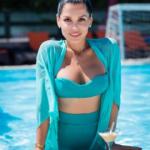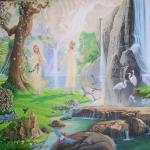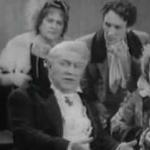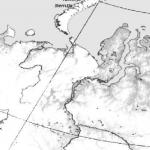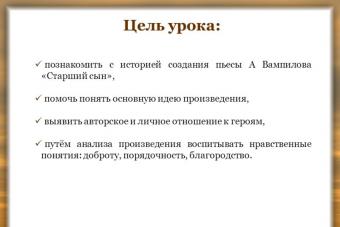1 of 22
Presentation - Arts
The text of this presentation
Kinds of art
Prepared by: Limanskaya Anna, 8 b

Art is a specific type of reflection and formation of reality by a person in the process of artistic creativity in accordance with certain aesthetic ideals. Types of art are divided into 3 main types: 1) Spatial; 2) temporal; 3) space-time.

1. SPATIAL KINDS OF ART Spatial arts are subdivided: - into fine arts: painting, sculpture, graphics, photography and others; non-visual arts: architecture, arts and crafts and artistic design (design).

SPATIAL Fine arts Fine art is a kind of art, the main feature of which is the reflection of reality in visual, visually perceived images. The visual arts include:
painting,
graphics,
sculpture,
photographic art

PAINTING - a kind of fine art, the works of which are created on a plane using colored materials. Painting is divided into:
easel
monumental
decorative

GRAPHICS - the art of depicting objects with contour lines and strokes. Sometimes the use of colored spots is allowed in the graphics.

SCULPTURE - a kind of fine art, the works of which have a physically material, objective volume and a three-dimensional form, placed in real space. The main objects of sculpture are man and images of the animal world. The main types of sculpture are round sculpture and relief.

PHOTO ART - the art of creating artistic photography

SPATIAL Non-Visual Arts
design (artistic design).
architecture
decorative and applied,

ARCHITECTURE - art: - design and construction of buildings; and - creating artistically expressive ensembles.

DECORATIVE ARTS is the field of plastic arts, whose works, along with architecture, artistically form the material environment surrounding a person. Decorative art is divided into: - monumental and decorative art; - arts and crafts; and - decorative arts.

DESIGN - artistic design of the objective world; development of samples of rational construction of the subject environment. - creative activity, the purpose of which is to determine the formal qualities of industrial products

2. TEMPORARY ARTS The temporary arts include: 1) music; 2) fiction.

Music is an art form that reflects reality in sound artistic images. Music can convey emotions, feelings of people, which is expressed in rhythm, intonation, melody. According to the method of performance, it is divided into instrumental and vocal.
. Music is also divided into: folk and classical modern jazz military spiritual

Fiction is a form of art that uses the words and constructions of natural (written human) language as the only material. Literature is a written form of the art of the word, in the broad sense of the word: the totality of any written texts.

3. SPATIAL-TIME (spectacular) KINDS OF ART These types of art include: 1) dance; 2) theater; 3) film art; 4) circus art.

DANCE is a kind of art in which artistic images are created by means of plastic movements and rhythmically clear and continuous changes in the expressive positions of the human body. Dance is inextricably linked with music, the emotional and figurative content of which is embodied in its choreographic composition, movements, figures.

THEATER is a kind of art that reflects reality, characters, events, conflicts, their interpretation and evaluation through a dramatic action that occurs in the process of playing an actor in front of an audience. In the course of historical development, three main types of theater were identified, differing in specific features and means of artistic expression: drama, opera and ballet theaters.

CINEMA ART is a kind of art, the works of which are created with the help of filming of real, or specially staged, or with the involvement of means of animation of events, facts, and phenomena of reality. It is a synthetic art form that combines literature, theatre, visual arts and music.
What is art? Art is a specific form of social consciousness and human activity, which is a reflection of the surrounding activity in artistic images. Art is a specific form of social consciousness and human activity, which is a reflection of the surrounding activity in artistic images.



Painting Painting is an art form whose work is a reflection of life on a certain surface with the help of color. Painting is an art form whose work is a reflection of life on a certain surface using color.

Sculpture Sculpture is a kind of fine art, the works of which have a physical material volume and a three-dimensional form placed in real space. Sculpture is a type of fine art, the works of which have a physical material volume and a three-dimensional form placed in real space.

Decorative and applied art Decorative and applied art is a type of fine art that is directly related to the everyday needs of people. Decorative and applied art is a type of fine art that is directly related to the everyday needs of people.


Music Music is a form of art that reflects reality in sound artistic images. Music is a kind of art that reflects reality in sound artistic images. Music is an art form that reflects reality in sound artistic images. Music is an art form that reflects reality in sound artistic images. music


slide 1
Types of art and their classification
slide 2

Art is a creative reflection, a reproduction of reality in artistic images.
Art exists and develops as a system of interconnected types, the diversity of which is due to the versatility of the (real world) itself, displayed in the process of artistic creation.
Art forms are historically established forms of creative activity that have the ability to artistically realize life content and differ in the ways of its material embodiment (word in literature, sound in music, plastic and color materials in fine arts, etc.).
slide 3

spatial or plastic arts
temporary or dynamic
spatio-temporal views or synthetic, spectacular
The existence of various types of arts is due to the fact that none of them, by its own means, can give an artistic comprehensive picture of the world. Such a picture can only be created by the entire artistic culture of mankind as a whole, consisting of individual types of art.
fine art architecture photography
music literature
choreography cinema theater
KINDS OF ART
slide 4

ARCHITECTURE
Architecture (Greek "architecton" - "master, builder") is a monumental art form, the purpose of which is to create structures and buildings necessary for the life and activities of mankind, responding to the utilitarian and spiritual needs of people.
The forms of architectural structures depend on geographical and climatic conditions, on the nature of the landscape, the intensity of sunlight, seismic safety, etc.
slide 5

ARCHITECTURE
Architecture is more closely connected than other arts with the development of the productive forces, with the development of technology. Architecture is able to combine with monumental painting, sculpture, decorative and other arts. The basis of the architectural composition is the three-dimensional structure, the organic interconnection of the elements of a building or an ensemble of buildings. The scale of the structure largely determines the nature of the artistic image, its monumentality or intimacy.
Architecture does not reproduce reality directly; it is not pictorial, but expressive.
slide 6

ART
graphics
sculpture
painting
Fine art is a group of types of artistic creativity that reproduce visually perceived reality. Works of art have an objective form that does not change in time and space.
Slide 7

GRAPHICS
Graphics (translated from Greek - "I write, draw") is, first of all, drawing and artistic printed works (engraving, lithography). It is based on the possibilities of creating an expressive art form by using lines, strokes and spots of different colors applied to the surface of the sheet.
Graphics preceded painting. At first, a person learned to capture the outlines and plastic forms of objects, then to distinguish and reproduce their colors and shades. The mastery of color was a historical process: not all colors were mastered at once.
Slide 8

GRAPHICS
The specifics of graphics are linear relationships. By reproducing the forms of objects, it conveys their illumination, the ratio of light and shadow, etc. Painting captures the real ratios of the colors of the world, in color and through color it expresses the essence of objects, their aesthetic value, calibrates their social purpose, their correspondence or contradiction to the environment. .
In the process of historical development, color began to penetrate into drawing and printed graphics, and now drawing with colored crayons - pastel, and color engraving, and painting with water colors - watercolor and gouache are already included in graphics. In various literature on art history, there are different points of view about graphics. In some sources, graphics is a type of painting, while in others it is a separate subspecies of fine art.
Slide 9

PAINTING
Painting is a flat visual art, the specificity of which lies in the representation with the help of paints applied to the surface of the image of the real world, transformed by the creative imagination of the artist.
monumental fresco (from Italian Fresco) - painting on wet plaster with paints diluted in water mosaic (from French mosaiqe) image of colored stones, smalt (Smalt - colored transparent glass.), ceramic tiles.
easel (from the word "machine") - a canvas that is created on an easel.
Slide 10

genres of painting. Portrait.
The main task is to convey the idea of the external appearance of a person, to reveal the inner world of a person, to emphasize his individuality, psychological and emotional image.
Peter Paul Rubens. "Portrait of the Maid Infanta Isabella", ca. 1625, Hermitage
Vasily Andreevich Tropinin Portrait of Pushkin
slide 11

genres of painting. Scenery.
Landscape - reproduces the surrounding world in all its variety of forms. The image of the seascape is defined by the term marinism.
Claude Monet. "Irises in Monet's Garden". 1900
Isaac Levitan. "Spring. Big water. 1897
slide 12

genres of painting. Still life.
Still life - the image of household items, tools, flowers, fruits. Helps to understand the worldview and way of a certain era.
Willem Kalf. Still life with porcelain vase, silver-gilt jug and goblets, c. 1643-1644.
Henri Fantin-Latour. Still life with flowers and fruits.
slide 13

genres of painting. Historical.
The historical genre is a genre of painting that originates in the Renaissance and includes works not only on the plots of real events, but also on mythological, biblical and gospel paintings.
The last day of Pompeii, 1830-1833, Bryullov
Slide 14

genres of painting. Domestic.
Household genre - reflects the daily life of people, the temper, customs, traditions of a particular ethnic group.
Mural painting with scenes from everyday life, Nakt's funerary storeroom, Ancient Egypt
Workshop of calligraphers and miniature masters, 1590-1595
slide 15

genres of painting. Iconography.
Icon painting (translated from Greek as "prayer image") is the main goal of directing a person on the path of transformation.
"Holy Trinity" by Andrei Rublev (1410)
Christ Pantocrator, one of the oldest icons of Christ, VI century, Sinai Monastery
slide 16

genres of painting. Animalism.
Animalism is the depiction of an animal as the protagonist of a work of art.
Albrecht Durer. "Hare", 1502
Franz Marc, Blue Horse, 1911
Slide 17

SCULPTURE
Sculpture is a spatial and visual art that explores the world in plastic images. The main materials used in sculpture are stone, bronze, marble, wood. At the present stage of development of society, technological progress, the number of materials used to create sculptures has expanded: steel, plastic, concrete and others.
Slide 18

SCULPTURE
monumental
monuments monuments memorials
easel
It is designed for viewing from a close distance and is intended for decorating interior spaces.
decorative
used to decorate everyday life (small plastic items)
Slide 19

ART AND APPLIED ARTS
Decorative and applied art is a kind of creative activity in the creation of household items designed to meet the utilitarian and artistic and aesthetic needs of people.
Decorative and applied arts include products made from a variety of materials and using various technologies. The material for the subject of DPI can be metal, wood, clay, stone, bone. The technical and artistic methods of manufacturing products are very diverse: carving, embroidery, painting, chasing, etc. The main characteristic feature of the DPI object is decorativeness, which consists in imagery and the desire to decorate, make it better, more beautiful.
Slide 20

ART AND APPLIED ARTS
slide 21

ART AND APPLIED ARTS
Decorative and applied art has a national character. Since it comes from the customs, habits, beliefs of a certain ethnic group, it is close to the way of life. An important component of decorative and applied arts is folk art crafts - a form of organizing artistic work based on collective creativity, developing a local cultural tradition and focused on the sale of handicrafts.
slide 22

wood carving
Bogorodskaya
Abramtsevo-Kudrinskaya
slide 23

The main folk crafts of Russia
wood painting
Polkhov-Maidanskaya Mezenskaya
slide 24

The main folk crafts of Russia
wood painting
Khokhloma Gorodetskaya
Slide 25

The main folk crafts of Russia
Decoration of birch bark products
birch bark embossing painting
slide 26

The main folk crafts of Russia
Artistic stone processing
hard stone processing soft stone processing
Slide 27

The main folk crafts of Russia
bone carving
Kholmogorskaya
Tobolsk
Slide 28

The main folk crafts of Russia
Miniature painting on papier-mâché
Fedoskino miniature
Mstyora miniature
Palekh miniature
Slide 29

The main folk crafts of Russia
Artistic metal processing
Veliky Ustyug black silver
Rostov enamel
Zhostovo painting on metal
slide 30

The main folk crafts of Russia
Gzhel ceramics Skopino ceramics
Folk pottery
Dymkovo toy Kargopol toy
Slide 31

The main folk crafts of Russia
Lace making
Vologda lace
Mikhailovskoe lace
slide 32

The main folk crafts of Russia
Painting on fabric
Pavlovian scarves and shawls
Slide 33

The main folk crafts of Russia
color intertwine
Embroidery
Vladimirskaya
Gold embroidery
slide 34

LITERATURE
Literature is a kind of art in which the material carrier of imagery is the word. The scope of literature includes natural and social phenomena, various social cataclysms, the spiritual life of the individual, her feelings. In its various genres, literature embraces this material either through a dramatic reproduction of an action, or through an epic narration of events, or through a lyrical self-disclosure of a person's inner world.
Slide 35

Literature
artistic
educational
historical
scientific
reference
slide 36

MUSICAL ART
Music - (from the Greek musike - lit. - the art of muses), a type of art in which musical sounds organized in a certain way serve as a means of embodying artistic images. The main elements and expressive means of music are mode, rhythm, meter, tempo, loud dynamics, timbre, melody, harmony, polyphony, instrumentation. Music is recorded in musical notation and realized in the process of performance.
Slide 37

MUSICAL ART
Music is shared
- genres - song, chorale, dance, march, symphony, suite, sonata, etc.
- for genera and types - theatrical (opera, etc.), symphonic, chamber, etc.;
Slide 38

CHOREOGRAPHY
Choreography (gr. Choreia - dance + grapho - writing) is a kind of art, the material of which is the movements and postures of the human body, poetically meaningful, organized in time and space, constituting an artistic system.
Slide 39

CHOREOGRAPHY
Dance interacts with music, together with it forming a musical and choreographic image. In this union, each component depends on the other: the music dictates its own laws to the dance and at the same time is influenced by the dance. In some cases, the dance can be performed without music - accompanied by clapping, tapping with heels, etc. The origins of the dance were: imitation of labor processes; ritual celebrations and ceremonies, the plastic side of which had a certain regulation and semantics; dance spontaneously expressing in movements in movements the culmination of a person's emotional state.
slide 43

PHOTO ART
A specific feature of photography is the organic interaction of creative and technological processes in it. Photo art developed at the turn of the 19th-20th centuries as a result of the interaction of artistic thought and the progress of photographic science and technology. Its emergence was historically prepared by the development of painting, which was oriented towards a mirror accurate image of the visible world and used the discoveries of geometric optics (perspective) and optical instruments (camera obscura) to achieve this goal. The specificity of photographic art lies in the fact that it gives a pictorial image of a documentary value.
Slide 44

CINEMA
Cinema is the art of reproducing on screen moving images captured on film, creating the impression of living reality. Cinema is an invention of the 20th century. Its appearance is determined by the achievements of science and technology in the field of optics, electrical and photographic engineering, chemistry, etc.
Cinema conveys the dynamics of the era; working with time as a means of expression, cinema is able to convey the change of various events in their internal logic.
Slide 45

The presentation was made by Vashchenko Tatyana Alexandrovna Thank you for your attention!!

Center for aesthetic education of children "Nuts" theater department
item
Topic 2 "Kinds of art"





photo
the circus
arts and crafts
sculpture
dance
art
folk art
music
stage
painting
theatre
architecture
movie

Kinds of art are historical forms of creative activity
Each type has individual ability artistic display of the real world
Each species has its own way of translating the idea:
- word in literature
- sound in music
- plastic and color materials in fine arts
- movement in dance, etc..

Different types of art - live, distributed, broadcast, either in space or in time. Or maybe totality of space and time then art belongs to space-time.

Species classification
Spatial (plastic)
Temporary (dynamic
Spatio-temporal

To spatial The types of art should include those types of art that live in space, spread in space. This is first of all fine arts, graphics, architecture, sculpture, etc.

Temporary arts are those types of art that spread over time, namely: music, dance, facial expressions. Time has nothing to do with sculpture, architecture, or painting, since they belong to the group of spatial arts.

Theater like cinema , occupies an intermediate position between the group of temporary arts and the group of spatial arts. Because it is a synthetic art. Thus, we attribute the theater to the spatio-temporal arts.



Art is as multifaceted as reality, is the soul of man .


What is art?

What kinds of art do you know?

What is spatial art? Why are they called that?

What is temporary art? Why?

What are spatio-temporal arts?

Every art form has its own means of expression. What do you think?

What kind of art interests you the most? Why?

creative homework
Using the expressive means of any kind of art to create your own little work.

Good luck in creativity !
slide 2
PAINTING
This is an image of artistic images in color. The word "painting" means to paint, that is, to write life. The art of painting was known in antiquity.
In painting, oil and watercolor paints, tempera, gouache are used.
Picturesque works are created on a plane (paper, canvas, wood, glass, wall).
slide 3
EASEL PAINTING
Easel painting is intended only for rooms and halls. These are paintings created on an easel (i.e., on a “machine”).
These works can be freely transferred from place to place.
V. Serov. Girl with peaches.
slide 4
MONUMENTAL PAINTING
Monumental painting is associated with architecture. These are large paintings that decorate the building from the inside and outside on the walls and ceilings. These are paintings, frescoes, mosaics, stained-glass windows.
Our Lady of Vladimir.
slide 5
MINIATURE PAINTING
Miniature painting adorns works of applied art, including jewelry. These are small paintings decorating handwritten books, medallions, watches, vases, bracelets.
N. Suloeva. Lyudmila in the garden of Chernomor.
slide 6
DECORATIVE PAINTING
Theatrical and decorative painting is associated with the design of the stage, with the manufacture of scenery.
Decorative painting to decorate buildings in the form of colorful panels, as well as household items (caskets, caskets, chests, dishes).
Slide 7
SCULPTURE
“Skulno” (lat.) - “I cut out”, “I carve”. These are three-dimensional images of a person, an animal, made in any material (wood, clay, plaster, stone, metal).
Slide 8
MONUMENTAL SCULPTURE
Monumental - has a large size and shape, because it is located on the streets, in parks, on the facades of houses and in spacious halls (monuments, decorative sculpture, reliefs).
Slide 9
easel sculpture
The size of the easel does not exceed the depicted object. It is located indoors, in residential buildings, museums, squares, parks. These are statues, portraits, genre scenes.
Boy's head. Ancient Rome. 1 in. n. e.
Slide 10
Its name comes from "grafo" (Greek) - "I write", "I draw", "I draw".
This is an image (drawing) made on paper or cardboard with a pen, pencil, charcoal, ink, felt-tip pens using lines, dashes, dots, strokes. Graphics are black and white and color. Graphic works are drawings, sketches, sketches, book illustrations, labels, newspaper and magazine cartoons, posters, posters, fonts for books.
slide 11
EASEL GRAPHICS
- Easel graphics decorate offices, galleries, apartment walls.
- Types of graphics - engraving, etching (on copper), lithography (on stone), woodcut (on wood)
Dutch engraving.
slide 12
BOOK GRAPHICS
Book graphics are related to the book. This is not only illustrations, but also font design. I. Bilibin.
Slide 14
INDUSTRIAL GRAPHICS
Industrial graphics are associated with industrial products (design of packaging, stamps, postcards, diplomas, labels, booklets, etc.).
slide 16
VOLUMETRIC STRUCTURES
- Civil structures - residential buildings, government, business buildings
- Cultural buildings - temples, churches, mosques, synagogues.
Slide 17
LANDSCAPE ARCHITECTURE
Landscape architecture planning of squares, boulevards, parks, pavilions, bridges, fountains.
Slide 18
URBAN PLANNING
Urban planning is the creation of new cities and towns, as well as the reconstruction (updating) of aged settlements.
Slide 19
DECORATIVE AND APPLIED ARTS
“Decor” (lat.) means “to decorate”, and “applied” indicates that things can be used in everyday life. These are artistically designed items that a person uses in everyday life (dishes, furniture, fabrics, tools, weapons, clothes, jewelry, carpets).
Since ancient times, folk craftsmen have been engaged in arts and crafts - one by one, uniting in craft artels, workshops, workshops or forming folk crafts.
View all slides
